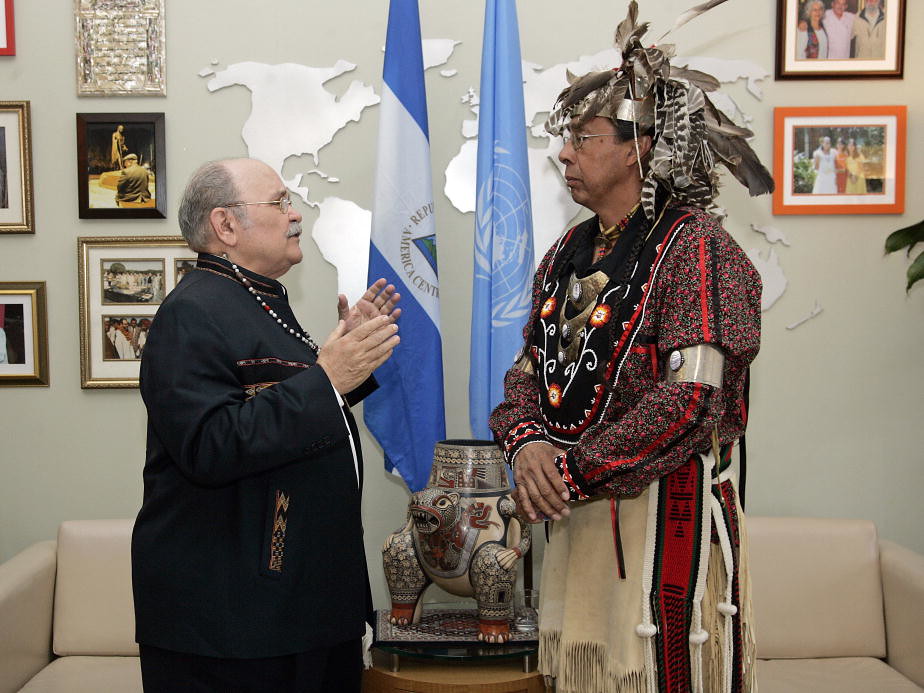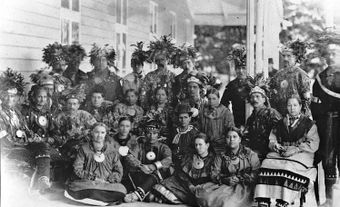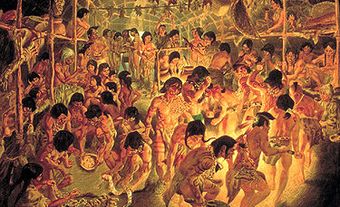The Onondaga are an Indigenous nation in Canada. They make up one-sixth of the Haudenosaunee Confederacy; the rest include the Kanyen’kehà:ka (Mohawk), Cayuga, Seneca, Oneida and Tuscarora. Onondaga traditional territory is located outside Syracuse, New York. Onondaga peoples also live on Six Nations territory near Brantford, Ontario. According to the Government of Canada, in January 2024, there were 711 registered members of the Bearfoot Onondaga First Nation and 892 registered members of the Onondaga Clear Sky First Nation. (See also First Nations.)

Traditional Territory
The ancestral homeland of the Onondaga is outside Syracuse, New York. Historically, their territory was in the middle of Haudenosaunee territory: Oneida and Kanyen’kehà:ka (Mohawk) lands lay to the east, while Seneca and Cayuga territory was to the west. Onondaga peoples also live on Six Nations territory near Brantford, Ontario. (See also Indigenous Territory.)
Traditional Life
The Onondaga, as well as other Haudenosaunee peoples, were often known as the “people of the longhouse.” Not only did the longhouse describe the type of dwelling in which they lived, but it also described the Haudenosaunee political alliance.
The Onondaga were known as the "firekeepers" of the Haudenosaunee Confederacy, serving as moderators at councils and keeping the wampum records of the confederacy. Despite this central position in the confederacy, they often pursued an independent policy. For example, in 1649, the Onondaga remained neutral while the Seneca and Kanyen’kehà:ka (Mohawk) defeated the Huron-Wendat.
The main Onondaga town, as "capital" of the Haudenosaunee Confederacy, was a hub of frontier diplomacy for two centuries.
Did you know?
Thadodaho (or Tadodaho) is the name given to a high chief in Haudenosaunee culture. The name is traced to a powerful Onondaga war chief (sometimes also called Atotarho) who was persuaded to accept peace and the Haudenosaunee alliance. (See also Hiawatha.)
History
In 1696, the French army under Frontenac invaded Onondaga country. With the 1701 Peace of Montreal, the Onondaga, as well as other Haudenosaunee peoples, made peace with the French.
During the American Revolution, Americans also burned Onondaga territory. After the war, a portion of the Onondaga immigrated with other Haudenosaunee peoples to lands in Canada on the Grand River, Ontario, in 1785. (See also Six Nations of the Grand River.)
Language and Culture
The Onondaga speak a language that is part of the Iroquoian linguistic family. (See also Indigenous Languages in Canada.)
Like other Haudenosaunee peoples, the Onondaga have a clan system. Clans designate social groups whose members trace descent from either male or female ancestors.
The Onondaga celebrate a variety of ceremonies that take place in the lunar year. For example, the Midwinter Ceremony begins at the start of the lunar new year and lasts 21 days. During this time, the Onondaga give thanks for their blessings.

 Share on Facebook
Share on Facebook Share on X
Share on X Share by Email
Share by Email Share on Google Classroom
Share on Google Classroom











